End-of-Year Giving: Fundraising Appeals Our Experts Love

Guest post by Amy Bills, Blackbaud’s director of customer marketing. Get ready to hear some great insights from an experienced marketing pro who has a passion for serving the nonprofit community and Blackbaud customers.

I came upon this last week on Twitter (see image to left).
Not the sort of thing a fundraiser wants to see right now.
But it’s a teachable moment. How do you break through the clutter? It matters all year, but becomes more urgent during end-of-year giving campaigns when inboxes and mailboxes are full to the brim.
I took the question to our in-house experts here at Blackbaud: the client success managers who work closely with our customers day in, day out.
Their advice? Tell a great story. Make it relevant. Make it easy to give. Be mindful of how your audience likes to receive information, and how they like to interact with you.
Here are 3 tips (with examples) to help you break through the year-end clutter.
1. Have a Sense of Urgency
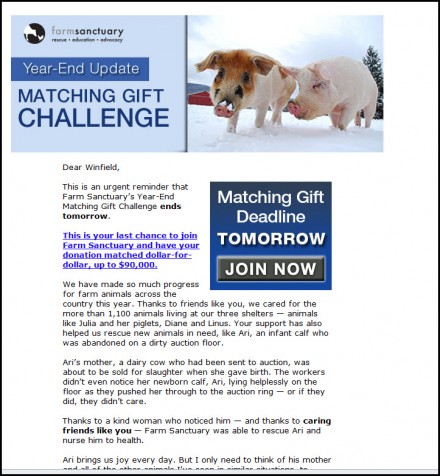
This is a typical outreach from Farm Sanctuary,” says Client Success Manager Winfield Nedrow. “They do a phenomenal job of connecting with their audience with short-term, achievable goals.”
What Winfield likes about this example:
- The picture and the challenge pull you in. Farm Sanctuary adds urgency to the message by establishing a timeline for action (Tomorrow!) to raise a specific dollar amount. Their sustaining donor appeals are carried out in the same manner.
- Farm Sanctuary’s email messaging is always consistent with their website messaging. It’s a cohesive experience for the recipient.
- They make it personal. They name their animals (“Julia,” “Diane,” “Linus,” “Ari”) to make a connection, rather than a more generic “Support the Pigs.” And the communication come from Gene Baur, with a photo of him and an animal. Note that his clothes and attitude are casual, not a suit and tie. His showing as well as telling what he’s all about.
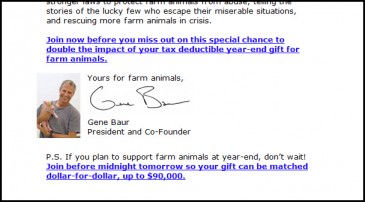
End-of-Year Fundraising Toolkit
Raise more with strategies and
best practices for year-end giving.
2. Use Powerful Words and Images
“The Colon Cancer Alliance created a compelling end-of-year appeal,” says Lead Client Success Manager Kate Seale. “It was a moving display of how this disease can affect anyone – and when donors can relate, they are motivated to take action.”
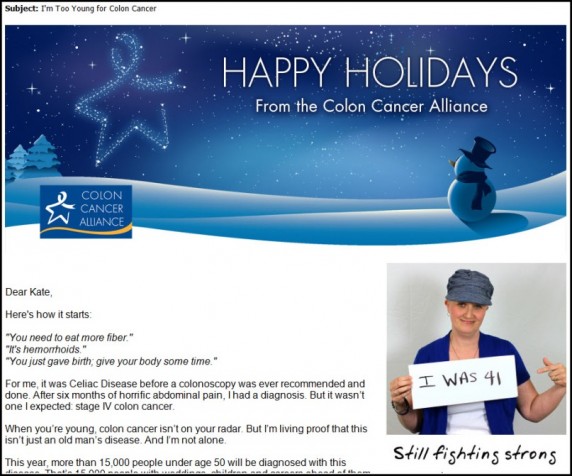
What Kate liked about this example:
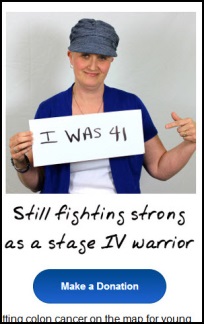
- It has a powerful subject line that stands out in the inbox. “I’m Too Young for Colon Cancer.” Jarring and impactful.
- It features a well-crafted story, written in the first person by someone affected by the disease and served by the organization. The story mixes concise and thoughtful copy (short, as it should be!) with powerful imagery. It’s easy to read and digest and the emotion comes through the copy.
- The call to action is clear and they provided supporting information on where the money goes. Our Next Generation of American Giving report tells us younger generations increasingly want validation of how funds are spent, so Colon Cancer Alliance is smart to pick up on that trend.
3. Incorporate Multipart Messages
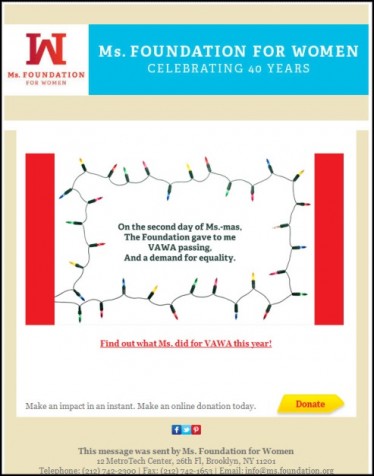
“The Ms. Foundation’s 12 Days of Ms.-mas is a clever way to create an ongoing communication stream, not just one and done,” says Lead Client Success Manager Mark Montenero.
What Mark liked about this example:
- Each day they add another accomplishment to the list. This keeps the communication alive beyond a single email or social media post and highlights specific accomplishments.
- They use each accomplishment to drive to more details about the relevant area. This is a modern approach to engaging people online: Not everyone wants to read about every item. They empower the recipient to choose.
- Ms. Foundation preselect the $100 level as the default on their donation form. Typically organizations don’t preselect, or simply preselect the first option on a form (the lowest amount). By preselecting $100, Ms. Foundation conveys that amount is the typical gift, and donors follow their lead.
The Year End is Here.
How will your organization stay top of mind?
End-of-Year Fundraising Toolkit
Raise more with strategies and
best practices for year-end giving.
